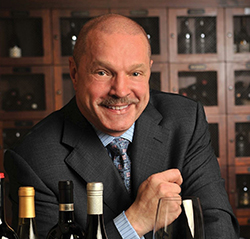
Steven Jones

Kelli Audrey White

Dan Petroski
St Supéry Sips Episode 5: Raise a Glass to Sauvignon Blanc Day
Wine drinkers around the world know chardonnay as Napa Valley’s signature white grape, but what some do not realize is that the region also produces beautifully complex sauvignon blanc. The valley is home to just 2,500 acres of sauvignon blanc, and nearly one-tenth of it is planted in the estate vineyards at St. Supéry Estate Vineyards and Winery. While the official date falls on May 6, you might say that every day is Sauvignon Blanc Day at St. Supéry.
In the latest episode of the St. Supéry Sips podcast, winery CEO Emma Swain discussed the appeal of sauvignon blanc and its future in the Napa Valley with guests Dan Petroski, winemaker and owner of Massican winery in Napa Valley; Kelli Audrey White, author of Napa Valley Then & Now; and Steven Jones, vice president of food and beverage for Gate Hospitality Group, operator of four luxurious private clubs in Florida.
One Grape, Many Expressions
A significant part of sauvignon blanc’s allure, guests noted, is its fascinating variety of expressions in different regions. “Napa Valley’s traditional signature runs a little bit more tropical—not quite as grassy as other parts of the world,” White said. “Even within the Napa Valley, there’s a huge range of styles.”
Sauvignon blanc drinkers are increasingly tuned in to these variations, she added, and they tend to seek out regions that produce particular styles. Some may prefer the grassy nuances of Marlborough, while others love the riper quality of Napa Valley or the minty, cucumber notes of South Africa.
This stylistic range makes sauvignon blanc a must-have variety at Gate Hospitality Group properties, because it provides flexibility for pairing the wines with a variety of dishes.
“In Florida, sauvignon blanc is very, very popular because of its approachability and its versatility,” said Jones. “It’s also in keeping with our environment of bright sunshine and ocean breezes, so it works very well for our climate.”
With supply issues presenting challenges in sourcing sauvignon blanc from New Zealand, Jones said he is looking into wines from regions such as South Africa, Uruguay and the United States.
Serious About Sauvignon
While sauvignon blanc is often thought of as a “cheap-and-cheerful” wine, there is a growing trend toward more elevated offerings. White said she is excited that producers are experimenting with different fermentation vessels and various levels of brightness to produce more complex wines.
“I’m seeing producers—Massican and St. Supéry are great examples—taking sauvignon blanc a lot more seriously,” she said. “They’re treating it with a lot of loving care, and not making it a kind of a cash flow support unit for cabernet production.”
For Petroski, the shift began around 2008. While working as the winemaker at Larkmead Vineyards, he made a conscious decision to take the winery’s sauvignon blanc from a fresh, bright “appetizer wine” to one deserving of a prominent place on the dinner table over the course of the meal.
“I think the whole Napa Valley took turns at figuring out what worked for them,” he said, whether it was the 100% new French oak approach of Phillipe Melka, or the brighter profiles of Honig, Long Meadow Ranch and Duckhorn. “The valley has done a great job of swinging the pendulum.”
Now, at Massican, Petroski makes an intensely fresh, northern Italian-style sauvignon blanc, and he sometimes blends the variety with grapes such as tocai friulano to create an aromatic “Cal-Ital” white wine.
An Uncertain Future in Napa Valley
Despite the growing popularity of sauvignon blanc in the U.S. market, acreage in the Napa Valley is shrinking. New plantings in the region are rare, and some growers are replacing existing vines with more profitable varieties.
The main reason, Petroski said, is because farmers see a bigger return on investment with cabernet sauvignon. “Three tons of cabernet sauvignon is worth $30,000 for you, whereas six tons of sauvignon blanc—which takes a little bit more time to harvest—is only worth $18,000.”
Although sauvignon blanc is a variety that deserves to be placed on a pedestal with cabernet sauvignon, he added, the grape simply doesn’t command the sort of pricing and demand to make it pencil out in Napa Valley.
Even so, Petroski does see some hope for the variety’s future there. Spurred by recent wildfires in Napa Valley, producers are looking to plant varieties that can be harvested earlier in the season—before fire danger ramps up—to provide economic security and cash flow. This, he said, may inspire a small bump in sauvignon blanc plantings.
Though the challenges are significant, White said she still believes in sauvignon blanc as Napa Valley’s white wine.
“In a sense, it’s a much better fit than chardonnay,” she said. “Chardonnay really needs a colder climate in order to stay interesting. Sauvignon blanc retains its quality at a higher crop load, and it responds well to our volcanic soils. I know these pesky market forces are hard to argue with, but from a purely qualitative standpoint, there’s a lot of reasons to favor sauvignon blanc. I think it’s really worth fighting for.”
# # #
Check Out These Sustainable Seafood Recipes
May 4, 2022